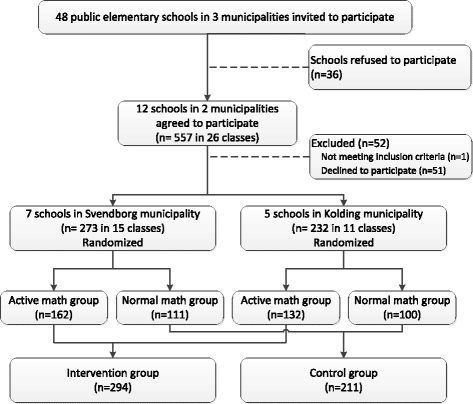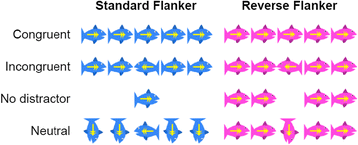Rationale and design of a randomized controlled trial examining the effect of classroom-based physical activity on math achievement
- PMID: 27068574
- PMCID: PMC4827169
- DOI: 10.1186/s12889-016-2971-7
Rationale and design of a randomized controlled trial examining the effect of classroom-based physical activity on math achievement
Abstract
Background: Integration of physical activity (PA) into the classroom may be an effective way of promoting the learning and academic achievement of children at elementary school. This paper describes the research design and methodology of an intervention study examining the effect of classroom-based PA on mathematical achievement, creativity, executive function, body mass index and aerobic fitness.
Methods: The study was designed as a school-based cluster-randomized controlled trial targeting schoolchildren in 1st grade, and was carried out between August 2012 and June 2013. Eligible schools in two municipalities in the Region of Southern Denmark were invited to participate in the study. After stratification by municipality, twelve schools were randomized to either an intervention group or a control group, comprising a total of 505 children with mean age 7.2 ± 0.3 years. The intervention was a 9-month classroom-based PA program that involved integration of PA into the math lessons delivered by the schools' math teachers. The primary study outcome was change in math achievement, measured by a 45-minute standardized math test. Secondary outcomes were change in executive function (using a modified Eriksen flanker task and the Behavior Rating Inventory of Executive Function (BRIEF) questionnaire filled out by the parents), creativity (using the Torrance Tests of Creative Thinking, TTCT), aerobic fitness (by the Andersen intermittent shuttle-run test) and body mass index. PA during math lessons and total PA (including time spent outside school) were assessed using accelerometry. Math teachers used Short Message Service (SMS)-tracking to report on compliance with the PA intervention and on their motivation for implementing PA in math lessons. Parents used SMS-tracking to register their children's PA behavior in leisure time.
Discussion: The results of this randomized controlled trial are expected to provide schools and policy-makers with significant new insights into the potential of classroom-based PA to improve cognition and academic achievement in children.
Trial registration: Clinicaltrials.gov: NCT02488460 (06/29/2015).
Keywords: Academic achievement; Classroom-based PA; Embodied cognition; Executive Functions; Methods; RCT; School children.
Figures



References
-
- Center on Education Policy . From the Capital to the Classroom. Washington: Center on Education Policy; 2007. Choices, changes, and challenges: curriculum and instruction in the NCLB era.
-
- National Association for Sport and Physical Education. Comprehensive school physical activity programs, position statement. Reston: 2008.
-
- Trost SG, van der Mars H. Why We Should Not Cut PE. Educational Leadership. 2009;67:60–65.
Publication types
MeSH terms
Associated data
LinkOut - more resources
Full Text Sources
Other Literature Sources
Medical

